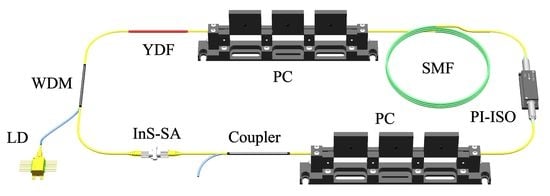Near-Infrared Optical Modulation for Ultrashort Pulse Generation Employing Indium Monosulfide (InS) Two-Dimensional Semiconductor Nanocrystals
Abstract
1. Introduction
2. Preparation and Characterization of the InS Sample
3. Experimental Setup and Results
4. Conclusions
Author Contributions
Funding
Conflicts of Interest
References
- Richardson, D.; Nilsson, J.; Clarkson, W. High power fiber lasers: Current status and future perspectives. JOSA B 2010, 27, B63–B92. [Google Scholar] [CrossRef]
- Fermann, M.E.; Hartl, I. Ultrafast fibre lasers. Nat. Photonics 2013, 7, 868–874. [Google Scholar] [CrossRef]
- Nishizawa, N. Ultrashort pulse fiber lasers and their applications. Jpn. J. Appl. Phys. 2014, 53, 090101. [Google Scholar] [CrossRef]
- Bonaccorso, F.; Sun, Z.; Hasan, T.; Ferrari, A.C. Graphene photonics and optoelectronics. Nat. Photonics 2010, 4, 611. [Google Scholar] [CrossRef]
- Sun, Z.; Hasan, T.; Torrisi, F.; Popa, D.; Privitera, G.; Wang, F.; Bonaccorso, F.; Basko, D.M.; Ferrari, A.C. Graphene Mode-Locked Ultrafast Laser. ACS Nano 2010, 4, 803–810. [Google Scholar] [CrossRef] [PubMed]
- Popa, D.; Sun, Z.; Torrisi, F.; Hasan, T.; Wang, F.; Ferrari, A.C. Sub 200 fs pulse generation from a graphene mode-locked fiber laser. Appl. Phys. Lett. 2010, 97, 203106. [Google Scholar] [CrossRef]
- Zhang, H.; Bao, Q.; Tang, D.; Zhao, L.; Loh, K. Large energy soliton erbium-doped fiber laser with a graphene-polymer composite mode locker. Appl. Phys. Lett. 2009, 95, 141103. [Google Scholar] [CrossRef]
- Wu, H.; Wu, J.; Yu, Q.; Zhang, K.; Xiao, H.; Leng, J.; Xu, J.; Zhou, P. Over 70 nm broadband-tunable Yb-doped fiber pulse laser based on trilaminar graphene. Laser Phys. Lett. 2017, 14. [Google Scholar] [CrossRef]
- Wang, J.; Wang, Y.; Wang, T.; Li, G.; Lou, R.; Cheng, G.; Bai, J. Nonlinear Optical Response of Graphene Oxide Langmuir-Blodgett Film as Saturable Absorbers. Nanomaterials 2019, 9, 640. [Google Scholar] [CrossRef]
- Zhao, L.M.; Tang, D.Y.; Zhang, H.; Wu, X.; Bao, Q.; Loh, K.P. Dissipative soliton operation of an ytterbium-doped fiber laser mode locked with atomic multilayer graphene. Opt. Lett. 2010, 35, 3622–3624. [Google Scholar] [CrossRef]
- Huang, S.; Wang, Y.; Yan, P.; Zhao, J.; Li, H.; Lin, R. Tunable and switchable multi-wavelength dissipative soliton generation in a graphene oxide mode-locked Yb-doped fiber laser. Opt. Express 2014, 22, 11417–11426. [Google Scholar] [CrossRef] [PubMed]
- Hou, L.; Guo, H.; Wang, Y.; Sun, J.; Lin, Q.; Bai, Y.; Bai, J. Sub-200 femtosecond dispersion-managed soliton ytterbium-doped fiber laser based on carbon nanotubes saturable absorber. Opt. Express 2018, 26. [Google Scholar] [CrossRef] [PubMed]
- Zhou, Y.; Lin, J.; Zhang, X.; Xu, L.; Gu, C.; Sun, B.; Wang, A.; Zhan, Q. Self-starting passively mode-locked all fiber laser based on carbon nanotubes with radially polarized emission. Photonics Res. 2016, 4, 327–330. [Google Scholar] [CrossRef]
- Hasan, T. Double-Wall Carbon Nanotubes for Wide-Band, Ultrafast Pulse Generation. ACS Nano 2014, 8, 4836–4847. [Google Scholar] [CrossRef] [PubMed]
- Kelleher, E.; Travers, J.; Ippen, E.; Sun, Z.; Ferrari, A.; Popov, S.; Taylor, J. Generation and direct measurement of giant chirp in a passively mode-locked laser. Opt. Lett. 2009, 34, 3526–3528. [Google Scholar] [CrossRef] [PubMed]
- Niu, K.; Sun, R.; Chen, Q.; Man, B.; Zhang, H. Passively mode-locked Er-doped fiber laser based on SnS2 nanosheets as a saturable absorber. Photonics Res. 2018, 6, 72–76. [Google Scholar] [CrossRef]
- Yang, Y.; Yang, S.; Li, C.; Lin, X. Passively Q-switched and mode-locked Tm-Ho co-doped fiber laser using a WS2 saturable absorber fabricated by chemical vapor deposition. Opt. Laser Technol. 2019, 111, 571–574. [Google Scholar] [CrossRef]
- Liu, W.; Liu, M.; OuYang, Y.; Hou, H.; Lei, M.; Wei, Z. CVD-grown MoSe2 with high modulation depth for ultrafast mode-locked erbium-doped fiber laser. Nanotechnology 2018, 29, 394002. [Google Scholar] [CrossRef]
- Luo, A.; Liu, M.; Wang, X.; Ning, Q.; Xu, W.; Luo, Z. Few-layer MoS2-deposited microfiber as highly nonlinear photonic device for pulse shaping in a fiber laser. Photonics Res. 2015, 3, A69. [Google Scholar] [CrossRef]
- Du, J.; Wang, Q.; Jiang, G.; Xu, C.; Zhao, C.; Xiang, Y.; Chen, Y.; Wen, S.; Zhang, H. Ytterbium-doped fiber laser passively mode locked by few-layer Molybdenum Disulfide (MoS2) saturable absorber functioned with evanescent field interaction. Sci. Rep. 2014, 4, 6346. [Google Scholar] [CrossRef]
- Li, L.; Jiang, S.; Wang, Y.; Wang, X.; Duan, L.; Mao, D.; Li, Z.; Man, B.; Si, J. WS2/fluorine mica (FM) saturable absorbers for all-normal-dispersion mode-locked fiber laser. Opt. Express 2015, 23, 28698. [Google Scholar] [CrossRef]
- Guo, B.; Yao, Y.; Xiao, J.; Wang, R.; Zhang, J. Topological Insulator-Assisted Dual-Wavelength Fiber Laser Delivering Versatile Pulse Patterns. IEEE J. Sel. Top. Quantum Electron. 2016, 22, 8–15. [Google Scholar] [CrossRef]
- Liu, W.; Pang, L.; Han, H.; Tian, W.; Chen, H.; Lei, M.; Yan, P.; Wei, Z. 70-fs mode-locked erbium-doped fiber laser with topological insulator. Sci. Rep. 2016, 6, 19997. [Google Scholar] [CrossRef] [PubMed]
- Xu, N.; Ming, N.; Han, X.; Man, B.; Zhang, H. Large-energy passively Q-switched Er-doped fiber laser based on CVD-Bi2Se3 as saturable absorber. Opt. Mater. Express 2019, 9, 373–383. [Google Scholar] [CrossRef]
- Chi, C.; Lee, J.; Koo, J.; Lee, J.H. All-normal-dispersion dissipative-soliton fiber laser at 1.06 µm using a bulk-structured Bi2Te3 topological insulator-deposited side-polished fiber. Laser Phys. 2014, 24, 105106. [Google Scholar] [CrossRef]
- Dou, Z.; Song, Y.; Tian, J.; Liu, J.; Yu, Z.; Fang, X. Mode-locked ytterbium-doped fiber laser based on topological insulator: Bi2Se3. Opt. Express 2014, 22, 24055–24061. [Google Scholar] [CrossRef] [PubMed]
- Mao, D.; Li, M.; Cui, X.; Zhang, W.; Lu, H.; Song, K.; Zhao, J. Stable high-power saturable absorber based on polymer-black-phosphorus films. Opt. Commun. 2018, 406, 254–259. [Google Scholar] [CrossRef]
- Luo, Z.; Liu, M.; Guo, Z.; Jiang, X.; Luo, A.; Zhao, C.; Yu, X.; Xu, W.; Zhang, H. Microfiber-based few-layer black phosphorus saturable absorber for ultra-fast fiber laser. Opt. Express 2015, 23, 20030–20039. [Google Scholar] [CrossRef]
- Xu, Y.; Jiang, X.; Ge, Y.; Guo, Z.; Zeng, Z.; Xu, Q.; Zhang, H.; Yu, X.; Fan, D. Size-dependent nonlinear optical properties of black phosphorus nanosheets and their applications in ultrafast photonics. J. Mater. Chem. C 2017, 5, 3007–3013. [Google Scholar] [CrossRef]
- Wang, T.; Jin, X.; Yang, J.; Wu, J.; Yu, Q.; Pan, Z.; Wu, H.; Li, J.; Su, R.; Xu, J.; et al. Ultra-stable pulse generation in ytterbium-doped fiber laser based on black phosphorus. Nanoscale Adv. 2019, 1, 195–202. [Google Scholar] [CrossRef]
- Hisyam, M.B.; Rusdi, M.F.M.; Latiff, A.A.; Harun, S.W. Generation of Mode-locked Ytterbium doped fiber ring laser using few-layer black phosphorus as a saturable absorber. IEEE J. Sel. Top. Quantum Electron. 2017, 23, 39–43. [Google Scholar] [CrossRef]
- Jana, M.K.; Pal, K.; Waghmare, U.V.; Biswas, K. The Origin of Ultralow Thermal Conductivity in InTe: Lone-Pair-Induced Anharmonic Rattling. Angew. Chem. 2016, 128, 7923–7927. [Google Scholar] [CrossRef]
- Ho, C.H.; Chu, Y.J. Bending Photoluminescence and Surface Photovoltaic Effect on Multilayer InSe 2D Microplate Crystals. Adv. Opt. Mater. 2015, 3, 1750–1758. [Google Scholar] [CrossRef]
- Sucharitakul, S.; Goble, N.J.; Kumar, U.R.; Sankar, R.; Bogorad, Z.A.; Chou, F.C.; Chen, Y.T.; Gao, X.P.A. Intrinsic Electron Mobility Exceeding 103 cm2/(V s) in Multilayer InSe FETs. Nano Lett. 2015, 15, 3815–3819. [Google Scholar] [CrossRef]
- Yang, W.; Xu, N.; Zhang, H. Nonlinear absorption properties of indium selenide and its application for demonstrating pulsed Er-doped fiber laser. Laser Phys. Lett. 2018, 15, 105101. [Google Scholar] [CrossRef]
- Xu, N.; Yang, W.; Zhang, H. Nonlinear saturable absorption properties of indium selenide and its application for demonstrating a Yb-doped mode-locked fiber laser. Opt. Mater. Express 2018, 8, 3092–3103. [Google Scholar] [CrossRef]
- Liu, K.; Xu, J.; Zhang, X. GaSe crystals for broadband terahertz wave detection. Appl. Phys. Lett. 2004, 85, 863–865. [Google Scholar] [CrossRef]
- Ho, C.H.; Hsieh, M.H.; Wu, C.C. Photoconductance and photoresponse of layer compound photodetectors in the UV-visible region. Rev. Sci. Instrum. 2006, 77, 113102. [Google Scholar] [CrossRef]
- Hu, P.; Wen, Z.; Wang, L.; Tan, P.; Xiao, K. Synthesis of Few-Layer GaSe Nanosheets for High Performance Photodetectors. ACS Nano 2012, 6, 5988–5994. [Google Scholar] [CrossRef]
- Hu, P.; Wang, L.; Yoon, M.; Zhang, J.; Feng, W.; Wang, X.; Wen, Z.; Idrobo, J.C.; Miyamoto, Y.; Geohegan, D.B.; et al. Highly Responsive Ultrathin GaS Nanosheet Photodetectors on Rigid and Flexible Substrates. Nano Lett. 2013, 13, 1649–1654. [Google Scholar] [CrossRef]
- Nishino, T.; Hamakawa, Y. Preparation and Properties of InS Single Crystals. Jpn. J. Appl. Phys. 1977, 16, 1291–1300. [Google Scholar] [CrossRef]
- Seyam, M.A.M. Optical and electrical properties of indium monosulfide (InS) thin films. Vacuum 2001, 63, 441–447. [Google Scholar] [CrossRef]
- Kushwaha, P.; Patra, A.; Anjali, E.; Surdi, H.; Singh, A.; Gurada, C.; Ramakrishnan, S.; Prabhu, S.S.; Gopal, A.V.; Thamizhavel, A. Physical, optical and nonlinear properties of InS single crystal. Opt. Mater. 2014, 36, 616–620. [Google Scholar] [CrossRef][Green Version]
- Ho, C.H.; Chen, Y.H.; Ho, J.H. Optical and photodetector properties of stripe-like InS crystal. RSC Adv. 2016, 6, 97445–97448. [Google Scholar] [CrossRef]
- Hollingsworth, J.A.; Poojary, D.M.; Clearfield, A.; Buhro, W.E. Catalyzed Growth of a Metastable InS Crystal Structure as Colloidal Crystals. J. Am. Chem. Soc. 2000, 122, 3562–3563. [Google Scholar] [CrossRef]
- Gasanly, N.M.; Özkan, H.; Aydinli, A.; Yilmaz, İ. Temperature dependence of the Raman-active phonon frequencies in indium sulfide. Solid State Commun. 1999, 110, 231–236. [Google Scholar] [CrossRef]
- Kumaresan, R.; Ichimura, M.; Sato, N.; Ramasamy, P. Application of novel photochemical deposition technique for the deposition of indium sulfide. Mater. Sci. Eng. B 2002, 96, 37–42. [Google Scholar] [CrossRef]
- Guo, B.; Lyu, Q.; Yao, Y.; Wang, P. Direct generation of dip-type sidebands from WS2 mode-locked fiber laser. Opt. Mater. Express 2016, 6, 2475–2486. [Google Scholar] [CrossRef]
- Ming, N.; Tao, S.; Yang, W.; Chen, Q.; Sun, R.; Wang, C.; Wang, S.; Man, B.; Zhang, H. Mode-locked Er-doped fiber laser based on PbS/CdS core/shell quantum dots as saturable absorber. Opt. Express 2018, 26, 9017–9026. [Google Scholar] [CrossRef]
- Garmire, E. Resonant optical nonlinearities in semiconductors. IEEE J. Sel. Top. Quantum Electron. 2000, 6, 1094–1110. [Google Scholar] [CrossRef]
- Nyushkov, B.N.; Denisov, V.I.; Kobtsev, S.M.; Pivtsov, V.S.; Kolyada, N.A.; Ivanenko, A.V.; Turitsyn, S.K. Generation of 1.7-μJ pulses at 1.55 μm by a self-mode-locked all-fiber laser with a kilometers-long linear-ring cavity. Laser Phys. Lett. 2010, 7, 661–665. [Google Scholar] [CrossRef]
- Denisov, V.I.; Nyushkov, B.N.; Pivtsov, V.S. Self-mode-locked all-fibre erbium laser with a low repetition rate and high pulse energy. Quantum Electron. 2010, 40, 25–27. [Google Scholar] [CrossRef]
- Wang, S.; Yu, H.; Zhang, H.; Wang, A.; Zhao, M.; Chen, Y.; Mei, L.; Wang, J. Broadband Few-Layer MoS2 Saturable Absorbers. Adv. Mater. 2014, 26, 3538–3544. [Google Scholar] [CrossRef]
- Woodward, R.I.; Kelleher, E.J.R.; Howe, R.C.T.; Hu, G.; Torrisi, F.; Hasan, T.; Popov, S.V.; Taylor, J.R. Tunable Q-switched fiber laser based on saturable edge-state absorption in few-layer molybdenum disulfide (MoS2). Opt. Express 2014, 22, 31113–31122. [Google Scholar] [CrossRef]

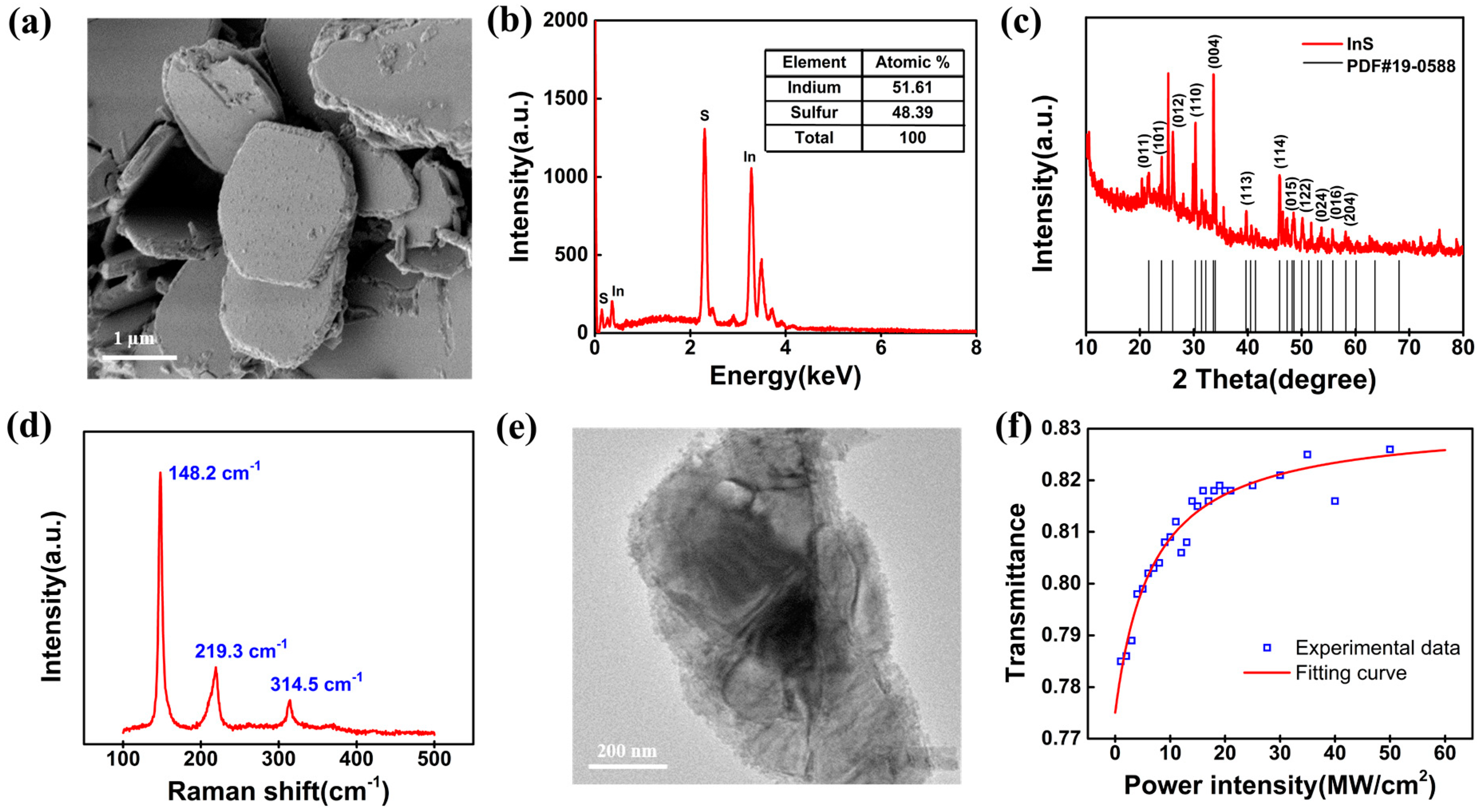
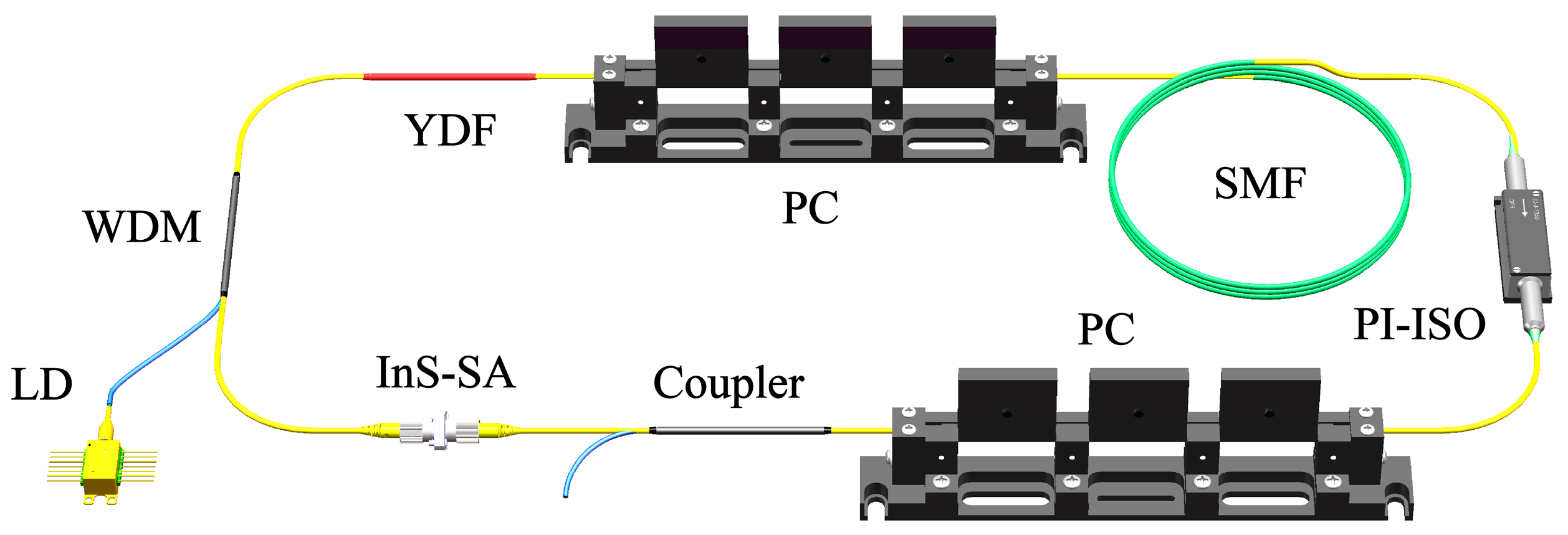
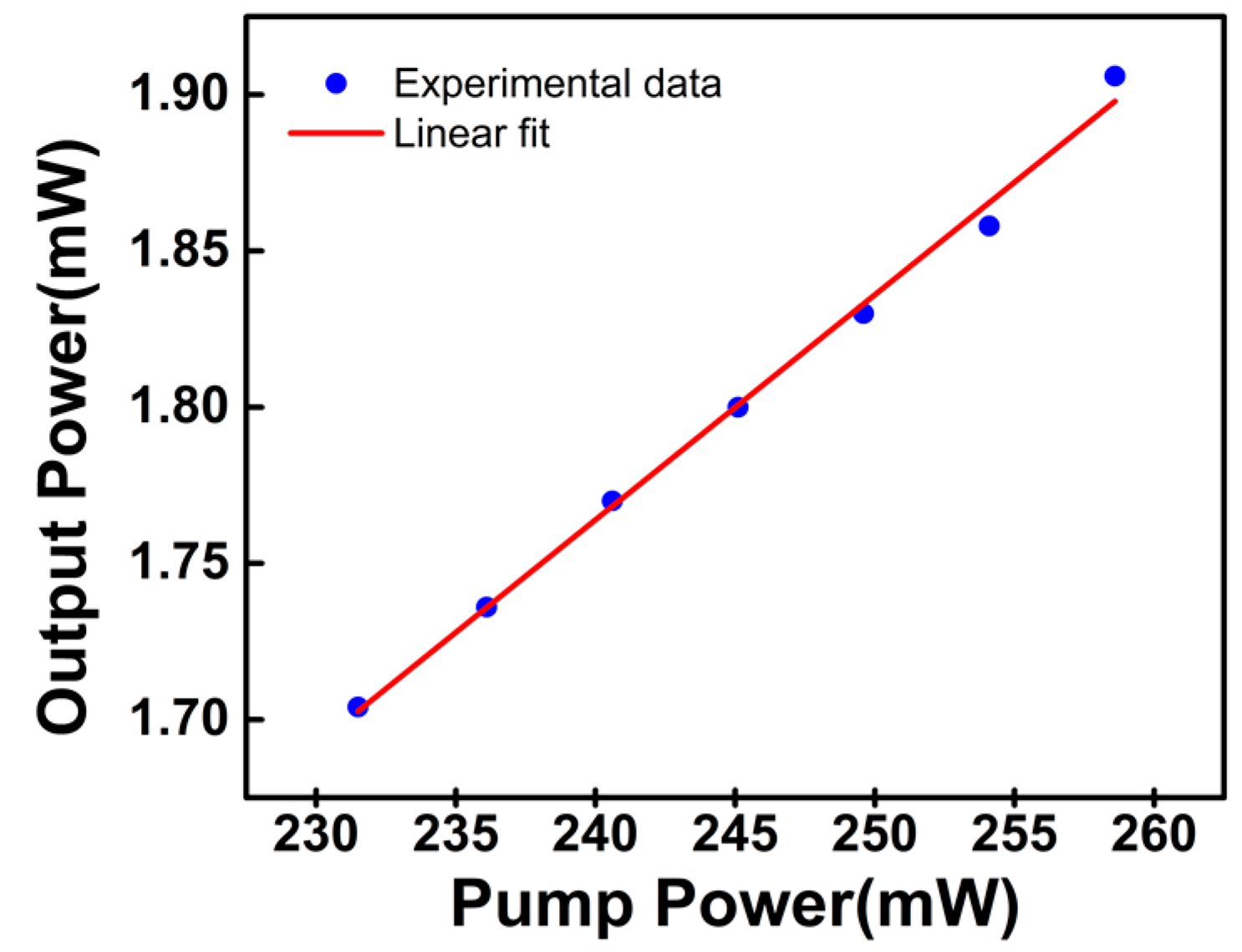
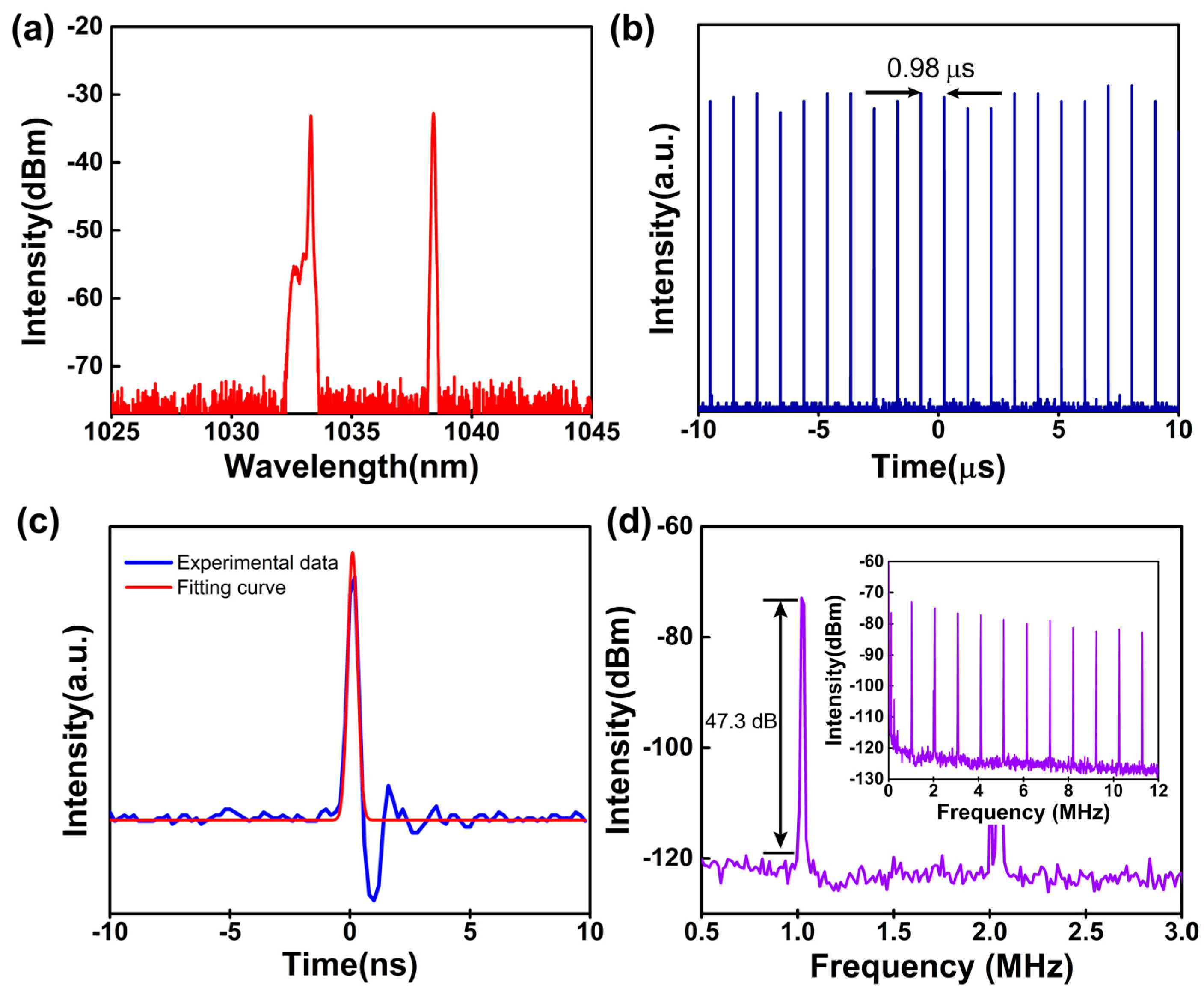

| SA | αs/Isat%/MW/cm2 | Repetition Rate (MHz) | Output Power (mW) | Pulse Width (ps) | Threshold (mW) | SNR (dB) | Reference |
|---|---|---|---|---|---|---|---|
| Graphene | 8/-- | 0.9 | 0.37 | 580 | 100 | >70 | 10 |
| Graphene oxide | 25.31/13.01 | 14.2 | 2.1 | 340 | 110 | 65 | 11 |
| CNT | -- | 16.37 | 0.12 | 4.85 | -- | 60 | 14 |
| CNT | -- | 0.177 | 0.60 | 1700 | -- | ~50 | 15 |
| MoS2 | 10.47/0.88 mW | 6.74 | 2.37 | 656 | 120 | 59 | 20 |
| WS2 | 5.8/ | 23.26 | 30 | 713 | 550 | 55 | 21 |
| Bi2Te3 | 1.8/92 W | 1.436 | 0.82 | 230 | 200 | ~77 | 25 |
| Bi2Se3 | 5.2/70 μJ/cm2 | 44.6 | 33.7 | 46 | 153 | 58 | 26 |
| BP | 8/0.35 | 13.5 | 80 | -- | 816 | 45 | 31 |
| InSe | 4.2/15.6 | 1.76 | 16.3 | 1370 | 185 | 45 | 36 |
| InS | 5.7/6.79 | 1.02 | 1.91 | 486.7 | 231.5 | 47 | Ours |
© 2019 by the authors. Licensee MDPI, Basel, Switzerland. This article is an open access article distributed under the terms and conditions of the Creative Commons Attribution (CC BY) license (http://creativecommons.org/licenses/by/4.0/).
Share and Cite
Wang, T.; Wang, J.; Wu, J.; Ma, P.; Su, R.; Ma, Y.; Zhou, P. Near-Infrared Optical Modulation for Ultrashort Pulse Generation Employing Indium Monosulfide (InS) Two-Dimensional Semiconductor Nanocrystals. Nanomaterials 2019, 9, 865. https://doi.org/10.3390/nano9060865
Wang T, Wang J, Wu J, Ma P, Su R, Ma Y, Zhou P. Near-Infrared Optical Modulation for Ultrashort Pulse Generation Employing Indium Monosulfide (InS) Two-Dimensional Semiconductor Nanocrystals. Nanomaterials. 2019; 9(6):865. https://doi.org/10.3390/nano9060865
Chicago/Turabian StyleWang, Tao, Jin Wang, Jian Wu, Pengfei Ma, Rongtao Su, Yanxing Ma, and Pu Zhou. 2019. "Near-Infrared Optical Modulation for Ultrashort Pulse Generation Employing Indium Monosulfide (InS) Two-Dimensional Semiconductor Nanocrystals" Nanomaterials 9, no. 6: 865. https://doi.org/10.3390/nano9060865
APA StyleWang, T., Wang, J., Wu, J., Ma, P., Su, R., Ma, Y., & Zhou, P. (2019). Near-Infrared Optical Modulation for Ultrashort Pulse Generation Employing Indium Monosulfide (InS) Two-Dimensional Semiconductor Nanocrystals. Nanomaterials, 9(6), 865. https://doi.org/10.3390/nano9060865



